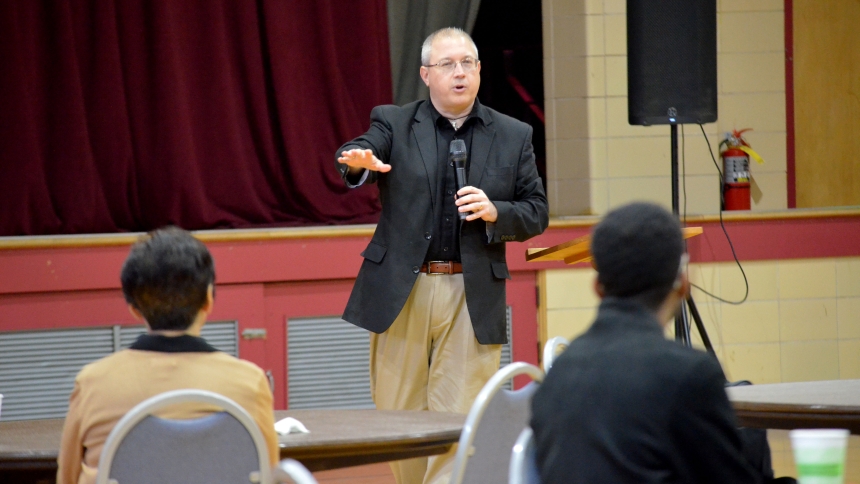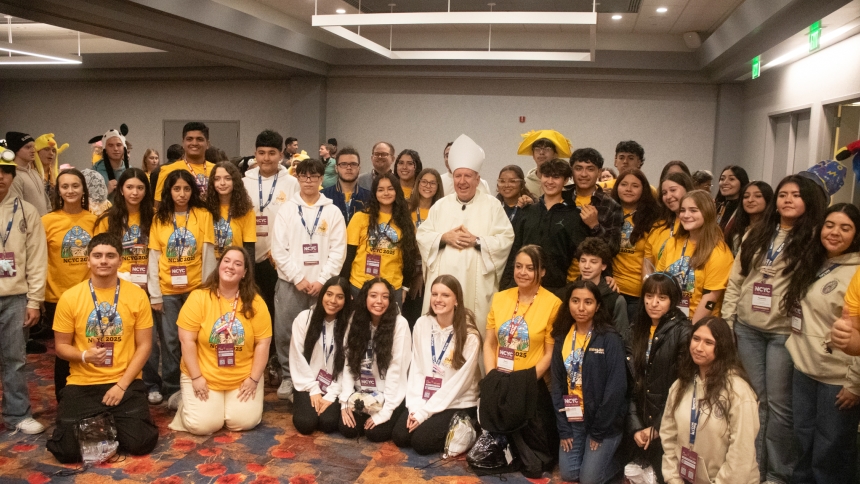
GARY - The Catholic Church is universally celebrating a Jubilee Holy Year, the 2025 anniversary of the Incarnation of our Lord. Following Mass at the Cathedral of the Holy Angels on June 1, Paul Jarzembowski, a native of the Diocese of Gary and associate director for the laity for the United States Conference of Catholic Bishops (USCCB), unpacked the history behind jubilee years.
“Paul is an expert in the Jubilee Year of Hope. The author of two books on hope, he has dedicated much time to the subject and has travelled across the country sharing his insights of hope in our everyday lives,” said Matt Kresich, a parishioner of the cathedral. “In his work with the USCCB, Paul is quite involved with the Jubilee Year, keen on its historic context and what is happening across the country. We are fortunate that such a highly qualified speaker has strong region ties.”
In the Catholic Church, a jubilee (or Holy Year) is a special time of grace and forgiveness, traditionally celebrated every 25 years. It's a period of spiritual renewal, reconciliation and indulgence. During these special celebrations, pilgrims are encouraged to visit designated churches and receive a plenary indulgence.
“What we are celebrating this year is the moment that God became physically present on planet Earth,” said Jarzembowski, an Andrean alum. “Why not take a whole year to celebrate that? That was the most transformational moment in human history for us to have God walk amongst us. To celebrate every 25 years, I don't think that's a bad reason for us to celebrate.”
Why is the Catholic Church celebrating?
Life is hard. Why celebrate? Jarzembowski noted that people go through their daily lives with a lot of pain and challenges, anxiety and heaviness. To be able to celebrate, he admits, may seem disingenuous as “we've got a lot of stuff going on in our lives.”
However, Jarzembowski pointed out that in some respects, the experiences in 2025 are not that different from how life was in 25. The Jewish people of Jesus' time were also faced with a lot of pain and a lot of depression. They had their own versions of polarization. Yet in the midst of that, Jesus asked them to be joyful.
“Jesus’s whole life was a jubilee of really pausing and turning things upside down,” Jarzembowski said.
Jesus spent most of his time with people for whom despair and hopelessness were normal and showed his followers how to live with hope.
“Jesus said ‘What is the most hopeless thing you can imagine? Death. Alright, fine. I'll die the worst possible death that you can imagine. I'll be sprung up on a cross.’ And yet, even with that, he says, ‘I need you to have hope.’ Hope was really his gift to us,” Jarzembowski said.
When Pope Francis chose hope as the theme of this year’s jubilee, Jarzembowski believes, he saw himself looking at a world not too dissimilar from the one Jesus faced. People are facing the impact of the COVID-19 pandemic, several wars, stark polarization and climate change.
“There's a mental health crisis we're facing, trust is being decimated, and people are ever more isolated, lonely and divided than ever before,” Jarzembowski added. “Pope Francis wanted to say in the midst of all that, ‘You kind of remind me of those Jewish people who were with Jesus back then.’”
The Church's history of jubilees
Jubilees have been a part of human tradition for centuries, dating back to the Book of Leviticus and Moses. Jarzembowski said Moses gave those he led out of Egypt instructions to take time to pause and reflect every 50 years since arriving in their new land.
Why 50? Jarzembowski explained that the number seven is a powerful symbol in the Bible and shared that seven years multiplied by seven times is 49.
“(Moses) told them at the end of the 50th year, the year after the seven times seven, ‘I need you to come and celebrate. I need you to celebrate the fact that you have found hope,’” Jarzembowski said.
The word "jubilee" originates from the Hebrew word “yobhel” or "yovel," which translates to "ram's horn" or "trumpet." In ancient times, the yobhel was used to announce the jubilee year, proclaiming to all those who heard it a time for liberty, justice, forgiveness and rest.
A jubilee is about forgiveness and the elimination of debts. So, as Jarzembowski described, if somebody owes another something during the jubilee year, they are encouraged to come together and say, “We're forgiven. We don't have to worry about it. I forgive your debt. We also make amends. If there's a dispute, we're going to reconcile.”
“It's a time to honor the God who gave us this new land, who gave us this new life,” Jarzembowski said. “We celebrate by saying, ‘Let's even the playing field. Let's balance the scales. That is what a jubilee was meant for.’”
Expounding on the practice of jubilee celebrations, Jarzembowski explained that the Jewish community held jubilees for many years. The first Christians right after Pentecost, he said, were still following Jewish customs. They would have participated in jubilee celebrations in the early Church, but that likely would have stopped after a couple of centuries.
In 1300, Pope Boniface VII revived the practice because the Church wanted to commemorate not the entrance into a new land, but the moment when God came among his people. That was the moment of the incarnation, and the Church decided to celebrate it, not just every 50 years, but every 25 years.
“We didn't always do it,” Jarzembowski said. “We took a couple of breaks – there were wars, there were famines, and (the Church) didn't actually live in Rome for a while, so it ebbed and flowed. We’ve been a little bit more regular since the 1800s.”
While the jubilees commemorated the incarnation and the divinity of Jesus, other jubilees also began to take place. A new trend was started to observe Jesus’ resurrection, ascension, and Pentecost. Jarzembowski said that it is done on the 33rd year after the zero, or the 50. Therefore, there will be another major jubilee in 2033 to commemorate Jesus's death and resurrection.
The Church can call a jubilee year at any time, Jarzembowski explained. For example, Pope Francis called for a jubilee in 2016 to commemorate the gift of mercy. It was not on the normal Church calendar, but the pontiff wanted to draw attention to the subject of mercy.
A time of homecoming and pilgrimage
One of the traditions of the Jubilee is for the faithful to return to their home, so it’s common during jubilees for Catholics to visit Rome. While some may travel to Rome, many will not.
“Recent popes have said, ‘That's fine. Make a pilgrimage in whatever way you can,’” Jarzembowski said. “So, there are these little Rome experiences.”
He shared that most bishops have designated their cathedrals as jubilee sites – places where, if the faithful can't go to Rome, they can still have a homecoming in their own diocese.
As a co-coordinator of the jubilee for the United States, part of Jarzembowski’s job involves gathering information about what different dioceses are doing to make sure people are aware of the events and places involved with the jubilee. A map of places that bishops have designated as pilgrimage sites is listed at usccb.org/jubilee2025.
Every one of the hundreds of sites around the country that people can visit is listed on the USCCB website page. Different bishops have designated certain churches as jubilee sites and others have included shrines and special places where saints were born.
Jarzembowski said Pope Francis, before he passed, designated one of the jubilee sites in Rome to be a prison. He explained it’s a jubilee site because the pope wanted to keep with the tradition of making jubilees point towards hope.
“He wanted to make sure that, yeah, you can go see these beautiful basilicas and their holy gates, but you should also go walk through a prison and visit the prisoners,” he said, “and go spend time with those who are in need the most.”
What are some things Catholics do during jubilee years?
Jarzembowski reiterated that the jubilee year is a time to “rest from our routine.” Catholics are encouraged to spend time in prayer, be more forgiving and have a remission of debt. It's also a time of charity and a time to have a rehabilitation of the soul.
“The sacrament of penance and reconciliation is very key to a jubilee year,” he said. “It's about repairing those relationships. It's about reconciliation between people and peace.”
Jarzembowski said he wouldn't be surprised if by the end of 2025, Pope Leo XIV became more involved in some peace initiatives around the world.
“There have been many jubilee years where that has been a cry of many popes – to declare peace in the world and to try to end fighting,” he said.
A pilgrimage, Jarzembowski said, is a really good analogy for a jubilee year because it's meant to be a journey on several levels. A pilgrimage might happen by accident, but it should be done with intentionality.
In Rome, there are five holy doors that the Vatican has designated: four major basilicas and a prison. The five holy doors in Rome are a special part of the jubilee year, as no one walks through them during the other 24 years.
“On the one side of the door is everything you have done in your life before entering that door,” Jarzembowski said. “And on the other side of that door is everything that's going to happen after that moment because you've been journeying to something, and now you're about to journey from something.”
Jarzembowski shared that the Sistine Chapel ceiling, painted in fresco by Michelangelo, was actually a jubilee project, as was the original idea to build the chapel.
“It wasn't built during the jubilee year, but it was announced that they were going to do a building project, so the Sistine Chapel itself is a jubilee project,” he said.
Likewise, World Youth Day, started by St. Pope John Paul II in the 1980s, was also a jubilee project. In the Jubilee Year of Redemption in 1983-84, Pope John Paul called the first ever gathering of young people to Rome, and it was so well received that the Church has been doing it ever since 1984.
“In fact, the symbol of World Youth Day is a cross that he has carried from every country,” Jarzembowski said. “That cross was standing in St. Peter's Basilica during the Jubilee Year of Redemption. It was kind of a special cross, and they decided to give it to the young people, and they continue to carry it around the whole world.”
What will you do to participate in the jubilee year?
Jarzembowski said the Jubilee Year of Hope is a good time for the faithful to try something new, such as a new practice. He encouraged those in attendance to reflect on how they will draw closer to Jesus during the remainder of the year. He asked them to think about things they may have been putting off doing that are important to their faith life, personal life and spiritual life.
“This might be a good year to start,” he said. “What's going to be your Sistine Chapel? What's your world this day? Think about what this year can be. What are you going to start that you think one day is going to do some incredible stuff.”
For more information on the Jubilee Year of Hope, visit dcgary.org/2025jubilee



